Inside Laserium
In The Beginning...
 Laserium, and indeed the laser light show itself, was born in the late 60's and early 1970's. Ivan Dryer, then a film maker, was treated to a lab demonstration of a new multi-colored laser at Cal Tech. He was so taken by the purity and intensity of the colors that he decided to make a film and set the beautiful patterns to music. His film, Laser Image, disappointed him though. Even though it was an enchanting visual piece, the lasers, as caught on film, lacked the original sizzle they had when seen live. Convinced that one had to experience laser light live, Ivan founded Laser Images in Van Nuys, California. He gathered together a group of clever optical, mechanical, and electrical engineers and artists who, in the next two years had crafted an advanced laser projector and choreographed the original Laserium show.
Laserium, and indeed the laser light show itself, was born in the late 60's and early 1970's. Ivan Dryer, then a film maker, was treated to a lab demonstration of a new multi-colored laser at Cal Tech. He was so taken by the purity and intensity of the colors that he decided to make a film and set the beautiful patterns to music. His film, Laser Image, disappointed him though. Even though it was an enchanting visual piece, the lasers, as caught on film, lacked the original sizzle they had when seen live. Convinced that one had to experience laser light live, Ivan founded Laser Images in Van Nuys, California. He gathered together a group of clever optical, mechanical, and electrical engineers and artists who, in the next two years had crafted an advanced laser projector and choreographed the original Laserium show.
Presenting the idea to the Griffith Observatory and Planetarium landed Ivan a temporary concession operating permit from the city of Los Angeles. Laserium opened its doors on November 19, 1973. Laserium expanded to many locations in the United States and abroad and has been experienced by over 20 million people. Laserium continues to produce new laser shows for tours and for music listening events. The company also produces outdoor laser shows, night club, trade show, and rock concert laser effects, and special effects for motion pictures and television.
About Light
When the universe came into being, all was light. Matter condensed from this energy forming the galaxies, stars, and planets that we study today. Light from the Sun supplies the Earth with all its energy. The energy we use in the form of electricity, and fossil fuels can all trace their origins to light energy from the Sun. The energy we derive from the food we eat, the energy of life, was all originally light. Light is an electromagnetic wave - a wave of changing electric and magnetic fields - that moves through space at Nature's speed limit, 186,282.397 miles per second. Nothing moves faster. Consider for a moment that light can travel around the Earth more than seven times in one second. It took the Apollo astronauts three days to reach the moon - it takes light about a second and a half to cover the same distance.
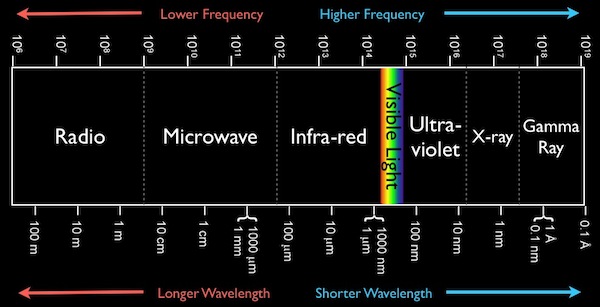
Light is made by wiggling electric charges. Whenever an electric charge wiggles, light is given off. Depending on how fast the charge wiggles (its frequency), it will produce different types of electromagnetic waves. Very slowly vibrating charges (only a couple thousand to a few million vibrations per second) produce radio waves. Slightly faster and you get TV and FM, then radar and microwaves. Faster yet and you produce infrared waves. When these hit you, the electromagnetic wave can cause molecules in your skin to start vibrating and you feel the effect as heat. The next increase in frequency brings us to visible light starting with red and proceeding through orange, yellow, green, blue, and violet. Even higher frequencies yield ultraviolet, x-rays, and gamma rays, all of which are invisible to the human eye. This tremendous set of frequencies is called the electromagnetic spectrum. Our eyes have evolved to use the frequencies most available from the Sun - visible light. Visible light only accounts for a very small range of possible frequencies in electromagnetic spectrum. If you picture the entire frequency range, from radio to gamma rays, as the notes on a piano, visible light would take up slightly less than an octave. However, the "electromagnetic piano" would not have the normal eight octaves of its musical counterpart, but a mind boggling 80 octaves. This keyboard would be forty-two feet long with the "visible light" notes near octave number 52. This would truly be a grand piano!
About Lasers
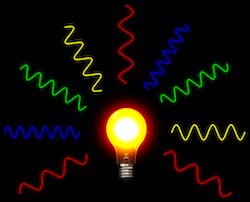
Light from the sun or an ordinary light bulb is a cacophonous mixture of many different waves. Sunlight contains waves of all frequencies, or colors, and the waves have no specific arrangement with respect to each other. All the waves are moving is all directions.
 The light from a laser is special. In laser light, the waves are very precisely aligned, crest to crest, trough to trough, and they only occur at a few specific frequencies. This has to do with the way laser light is made.
The light from a laser is special. In laser light, the waves are very precisely aligned, crest to crest, trough to trough, and they only occur at a few specific frequencies. This has to do with the way laser light is made.
When electrons surrounding atoms are excited, they jump from a lower energy inner "orbit" to a higher energy outer "orbit." Now, most of the time, the electrons immediately jump back, giving up the energy they gained as light. This is what you see in a neon sign or a fluorescent lamp. In the laser, the electron gets into a special excited state where it becomes "stuck" until some external disturbance comes along to dislodge it. Once dislodged, the excited electron falls to its lower energy state with an accompanying pulse of light. This external disturbance could be a bump from a nearby atom or a neighboring pulse of light passing nearby. The disturbing light pulse stimulates the excited atom to emit its energy as a light pulse, and this new pulse of light moves off in the same direction as the disturbing pulse with both of their waves precisely aligned. This "stimulated emission" is the key to the operation of the laser, for now these two pulses can stimulate other excited atoms to give off theirenergy in the same way, and, like an avalanche, a huge light pulse builds up (or, in scientific terms, is amplified). The word "laser" is an acronym for Light Amplification by the Stimulated Emission of Radiation.
In practice, the laser light builds up slowly, so the laser usually consists of a tube or rod with highly reflective mirrors at each end. The light bounces back and forth between the mirrors getting brighter and brighter with each pass through the excited atoms. One of the mirrors, like a two-way security mirror, is very slightly transparent and lets through about 1% of the light. This escaped light is what forms the powerful laser beams we use for our light show, what eye surgeons use to spot weld a detached retina, and what is used to cut solid steel.
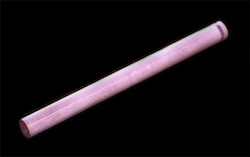
The laser medium between the mirrors can be a solid, liquid, or gas. To excite a solid, a flash lamp is set off very nearby. This light causes the solid rod to glow. These lasers only give off short pulses of light. The rods are made of different glasses, or even of solid ruby like the one to the right.
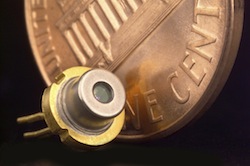
Nowadays, another solid laser, the diode laser, has become very popular. Diode lasers are the size of a grain of sand and now can be found in colors across the visible spectrum and beyond. These lasers are found everywhere from your CD player to projection pointers.
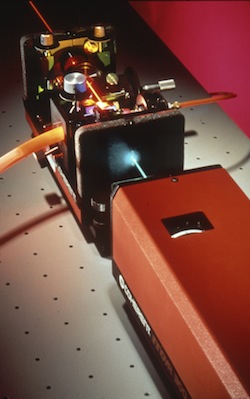
Liquid lasers, often called "dye lasers" because they use a liquid dye as a lasing medium, are excited with flashlamps, or even with another laser like the one to the right. Some of these liquid dye lasers can be tuned to produce a variety of colors.
 Gas lasers are the most common types, and many people have seen the red-colored Helium-Neon lasers used for surveying, education, and projection pointers (A HeNe tube can be see to the left). Gas lasers excite the electrons by passing electricity through the gas, making it glow like a neon sign. Laserium uses two identical gas lasers. They both have Krypton and Argon gas and produce a greenish-white beam. We use a prism to break this beam into its component red, yellow, green and blue beams.
Gas lasers are the most common types, and many people have seen the red-colored Helium-Neon lasers used for surveying, education, and projection pointers (A HeNe tube can be see to the left). Gas lasers excite the electrons by passing electricity through the gas, making it glow like a neon sign. Laserium uses two identical gas lasers. They both have Krypton and Argon gas and produce a greenish-white beam. We use a prism to break this beam into its component red, yellow, green and blue beams.
Laser Applications
Because of the special properties of laser light, many new and revolutionary applications have become possible in areas of communications, medicine, measurement, holography, energy generation, entertainment, and sadly, warfare.
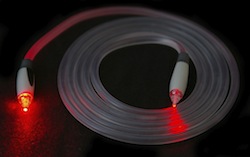 In communication, diode lasers are used to inject light into optical fibers, which act like wires, carrying the light signal to the fiber's other end. Here the signal is received and decoded. These fibers can be 20 miles long. With such systems, telephone companies can simultaneously transmit millions of telephone calls along a single fiber the diameter of a human hair, a huge savings over an equivalent copper-wire system.
In communication, diode lasers are used to inject light into optical fibers, which act like wires, carrying the light signal to the fiber's other end. Here the signal is received and decoded. These fibers can be 20 miles long. With such systems, telephone companies can simultaneously transmit millions of telephone calls along a single fiber the diameter of a human hair, a huge savings over an equivalent copper-wire system.
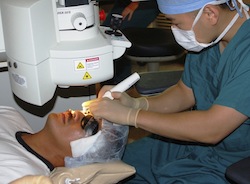 Doctors now use lasers in a variety of applications. In particularly bloody operations, the laser can be used as a scalpel with the distinct advantage of cauterizing the incision as it's made. The laser-knife is also perfectly sterile because the only thing touching the patient is light. Tattoos and other specific types of skin markings can be removed with a laser. Using pulsed lasers, an eye surgeon can spot-weld a detached retina to its proper place on the back of the eye without any cutting or discomfort to the patient. By routing the powerful laser light down a fiber, a cardiologist will someday remove the plaque from the inside of arteries, reducing clogging that can lead to heart attacks and strokes.
Doctors now use lasers in a variety of applications. In particularly bloody operations, the laser can be used as a scalpel with the distinct advantage of cauterizing the incision as it's made. The laser-knife is also perfectly sterile because the only thing touching the patient is light. Tattoos and other specific types of skin markings can be removed with a laser. Using pulsed lasers, an eye surgeon can spot-weld a detached retina to its proper place on the back of the eye without any cutting or discomfort to the patient. By routing the powerful laser light down a fiber, a cardiologist will someday remove the plaque from the inside of arteries, reducing clogging that can lead to heart attacks and strokes.
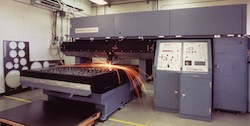 Just as doctors can spot-weld a delicate retina, industrial lasers can spot-weld or even cut solid steel. Shining a laser on a piece of steel only heats the outer surface so that manufacturers only harden the crucial outer layers without changing the internal structure of a piece. Most of the Levi's that you wear are cut from thick stacks of denim material by laser.
Just as doctors can spot-weld a delicate retina, industrial lasers can spot-weld or even cut solid steel. Shining a laser on a piece of steel only heats the outer surface so that manufacturers only harden the crucial outer layers without changing the internal structure of a piece. Most of the Levi's that you wear are cut from thick stacks of denim material by laser.
 Almost everyone now carries a three-dimensional hologram around - on their credit card. Holograms are produced with lasers. To make a hologram, the laser is split into two beams. Both beams are expanded with a lens. After a couple reflections from mirrors, one beam shines directly on the photographic plate, the other shines on the object being photographed. Light reflects from the object and also exposes the plate. The two sources combine and interfere with each other to create the hologram. If you took a hologram and broke it into many pieces, you'd notice that each piece has a complete picture of the object - but each fragment contains a picture from a different viewpoint. The first holograms had to be "played back" a with laser, but it wasn't long before white-light holograms made the scene. Holography can be used by scientists and engineers to make very accurate measurements of motion and shape changes. Research is now being done with X-ray lasers that will allow scientists to take three- dimensional holograms of living cells.
Almost everyone now carries a three-dimensional hologram around - on their credit card. Holograms are produced with lasers. To make a hologram, the laser is split into two beams. Both beams are expanded with a lens. After a couple reflections from mirrors, one beam shines directly on the photographic plate, the other shines on the object being photographed. Light reflects from the object and also exposes the plate. The two sources combine and interfere with each other to create the hologram. If you took a hologram and broke it into many pieces, you'd notice that each piece has a complete picture of the object - but each fragment contains a picture from a different viewpoint. The first holograms had to be "played back" a with laser, but it wasn't long before white-light holograms made the scene. Holography can be used by scientists and engineers to make very accurate measurements of motion and shape changes. Research is now being done with X-ray lasers that will allow scientists to take three- dimensional holograms of living cells.
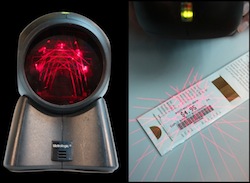 Many jobs are done by scanning a laser . If the laser is scanned in a flat circle (like holding a flashlight out in front of you and twirling around) it scans out flat plane. Surveyors use these laser- generated planes to establish a level. Bulldozers and plows can be guided by scanning lasers to produce perfectly flat (or perfectly tilted) plots and fields. In the supermarket, scanning lasers reflect off the striped UPC stripes on packages, speeding up your checkout.
Many jobs are done by scanning a laser . If the laser is scanned in a flat circle (like holding a flashlight out in front of you and twirling around) it scans out flat plane. Surveyors use these laser- generated planes to establish a level. Bulldozers and plows can be guided by scanning lasers to produce perfectly flat (or perfectly tilted) plots and fields. In the supermarket, scanning lasers reflect off the striped UPC stripes on packages, speeding up your checkout.
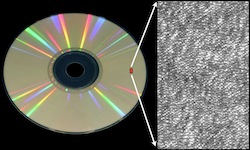
Rather than moving the laser over your CD or video disk, the disk, instead, turns over the laser. Microscopic pits in the disk are read and converted back into high fidelity video and sound. Your computer can use the same CD technology to store hundreds of pictures or tens of thousands of pages of text on a single disk.
Because the waves of laser light are aligned, and the laser is so finely controllable, the laser is a superb measuring tool. Using lasers, scientists can measure distance smaller than the size of an atom. Even over great distances they are extremely accurate.
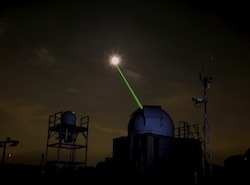
Using reflectors left on the moon by the American and Soviet space programs, scientists using powerful lasers can measure the distance to the moon to an accuracy of less than six inches!
The utility of lasers hasn't been lost on the military. Although it may be a long time before we'll see a Star Trek-type hand held death ray, experimental lasers capable of shooting down missiles have been developed that can be mounted on a tank or plane. Laser guided missiles follow a spot of laser light placed on the target by a soldier on the ground, or from a plane in the air. These deadly missiles have pinpoint accuracy as we saw during Desert Storm. Of course, Laserium is dedicated to the peaceful, safe, and artistic use of lasers.
In entertainment, lasers are used just about everywhere from planetariums, to rock concerts, to trade shows. We've even been invited to a few weddings! How do we perform our magic? Read on.
Inside Laserium
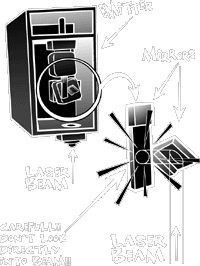 Now you know how a laser works, but how in the world can a laser be used to produce the myriad of images that you see in a Laserium light show? It's (almost) all done with mirrors.
Now you know how a laser works, but how in the world can a laser be used to produce the myriad of images that you see in a Laserium light show? It's (almost) all done with mirrors.
Inside the Laserium projector, the greenish-white beam from the krypton laser is broken into the four colors with a prism. Each beam is then routed to a pair of very small vibrateable mirrors. One mirror deflects the beam back and fourth and the other mirror deflects the beam up and down. The laserist's console is actually a sophisticated visual synthesizer which generates the signals sent to the vibrating mirrors.
Laserium , like television and movies, really depends on an interesting phenomenon called persistence of vision. If something moves quickly enough, your vision will blur and smooth the image. If the laser is simply shined on the dome, you will see only a bright dot of light. If the dot of laser light is moved quickly enough though, your persistence of vision the dot stretches out into a line. The same thing happens on your TV set or computer monitor. There's really only one dot of light there. First it paints the top line. Then it moves down and paints another. Eventually, 1/60th of a second later or so, it paints the last line at the bottom of the screen. You don't see the moving dot, you see the picture it quickly paints. If we move our laser dot fast enough, your eye can no longer distinguish the motion of the dot at all. It's really there, but you're vision isn't quick enough to perceive it and you see one of our beautiful laser designs.
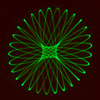 Our simplest figure to generate is called a cycloid. We make cycloids by adding circles to circles, just like you might do with a SpirographTM toy. The appearance of the cycloid depends on several factors. First, it depends on the speeds, or frequencies, of the two circles, just as the pattern of the Spirograph depends on the number of teeth in each gear. Second, it depends on the size of the circles (where you put the pen in the gear of the Spirograph.) Also important is whether the circles move in the same direction or in opposite directions. When they move in the same direction you get a class of cycloids with points or loops on the inside (we call these "innies"). When the circles move in opposite directions... you guessed it "outies." We're not limited to two circles like a spirograph, we can add up to six circles together making cycloids of great complexity.
Our simplest figure to generate is called a cycloid. We make cycloids by adding circles to circles, just like you might do with a SpirographTM toy. The appearance of the cycloid depends on several factors. First, it depends on the speeds, or frequencies, of the two circles, just as the pattern of the Spirograph depends on the number of teeth in each gear. Second, it depends on the size of the circles (where you put the pen in the gear of the Spirograph.) Also important is whether the circles move in the same direction or in opposite directions. When they move in the same direction you get a class of cycloids with points or loops on the inside (we call these "innies"). When the circles move in opposite directions... you guessed it "outies." We're not limited to two circles like a spirograph, we can add up to six circles together making cycloids of great complexity.
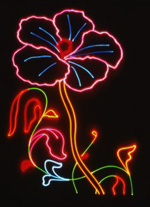 Another way to make pictures is to trace them out dot to dot, just like you did in a connect-the-dots book as a kid. The x and y position of our dots are held in a computer and the beam is sent from one to another so fast all you see is a picture. With a very fast shutter, called an "Acoustic Optic Modulator," we can turn the beam on and off so that we can make disconnected objects from a single continuously moving beam. In essence, the AO modulator lets us "lift the pen" from the paper. We actually use an advanced form of AO modulator called a "Poly-Chromatic Acousto-optic Modulator" (PCAOM) that allows us to vary the intensity of each laser color individually. This way we can draw full color graphics with hundreds of colors.
Another way to make pictures is to trace them out dot to dot, just like you did in a connect-the-dots book as a kid. The x and y position of our dots are held in a computer and the beam is sent from one to another so fast all you see is a picture. With a very fast shutter, called an "Acoustic Optic Modulator," we can turn the beam on and off so that we can make disconnected objects from a single continuously moving beam. In essence, the AO modulator lets us "lift the pen" from the paper. We actually use an advanced form of AO modulator called a "Poly-Chromatic Acousto-optic Modulator" (PCAOM) that allows us to vary the intensity of each laser color individually. This way we can draw full color graphics with hundreds of colors.
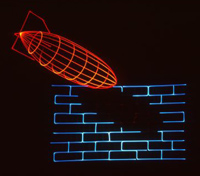 The use of a computer along with our specially designed ChoreoGraphics hardware and software (no longer available) have allowed us to bring the third dimension, depth, to Laserium. We can now design three dimensional objects which rotate and move as the computer calculates where the drawing points must be on the dome. The computer can also dim and make smaller the "farther parts" of the object enhancing the illusion of depth.
The use of a computer along with our specially designed ChoreoGraphics hardware and software (no longer available) have allowed us to bring the third dimension, depth, to Laserium. We can now design three dimensional objects which rotate and move as the computer calculates where the drawing points must be on the dome. The computer can also dim and make smaller the "farther parts" of the object enhancing the illusion of depth.
 Spirals are one of Laserium's most beautiful patterns. To make a spiral, you start with a normal cycloid and make it big and small very fast. A circle getting big and small makes the simplest type of spiral, but we arent limited to just a circle. If you move a spiral in a circle, you can get a nautilus-shaped figure. Before we go further with spirals, there are two ways we modify the moving dot. We can turn it on and off, a method called "chopping," and we can change its color, which we call "color modulation." This is how we produce the hypnotic mandala-like patterns on the planetarium's dome.
Spirals are one of Laserium's most beautiful patterns. To make a spiral, you start with a normal cycloid and make it big and small very fast. A circle getting big and small makes the simplest type of spiral, but we arent limited to just a circle. If you move a spiral in a circle, you can get a nautilus-shaped figure. Before we go further with spirals, there are two ways we modify the moving dot. We can turn it on and off, a method called "chopping," and we can change its color, which we call "color modulation." This is how we produce the hypnotic mandala-like patterns on the planetarium's dome.
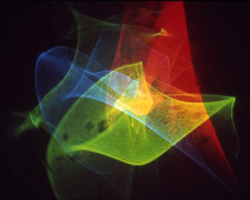 One last secret we'll give away is how we produce the beautiful clouds and aurorae. This is actually our simplest effect. All we do is shine the laser through rippled plastic or glass like you might find on a shower door or a bathroom window. Move the plastic slowly in front of the beam, and the cloud comes alive.
One last secret we'll give away is how we produce the beautiful clouds and aurorae. This is actually our simplest effect. All we do is shine the laser through rippled plastic or glass like you might find on a shower door or a bathroom window. Move the plastic slowly in front of the beam, and the cloud comes alive.
All these effects would be nothing without the talents of many people. In our studios in Van Nuys, music is painstakingly chosen, digitally edited, and woven together to provide proper pacing for the show. The soundtrack is then played hundreds of times as our choreographers imagine and invent the visual images. Animators bring to life cartoons and three-dimensional imagery. Some of this initial choreography is pre-recorded on the same tape as the music. Over the period of several months the show slowly takes shape. The musical soundtrack and choreography data is then delivered to our laserists who add their live performance layer to the original choreography. Every laserist adds his or her own touch and signature to the show, and since every show is performed live, no two shows are alike. Laserium IS music for your eyes.


 The light from a laser is special. In laser light, the waves are very precisely aligned, crest to crest, trough to trough, and they only occur at a few specific frequencies. This has to do with the way laser light is made.
The light from a laser is special. In laser light, the waves are very precisely aligned, crest to crest, trough to trough, and they only occur at a few specific frequencies. This has to do with the way laser light is made.



 Gas lasers are the most common types, and many people have seen the red-colored Helium-Neon lasers used for surveying, education, and projection pointers (A HeNe tube can be see to the left). Gas lasers excite the electrons by passing electricity through the gas, making it glow like a neon sign. Laserium uses two identical gas lasers. They both have Krypton and Argon gas and produce a greenish-white beam. We use a prism to break this beam into its component red, yellow, green and blue beams.
Gas lasers are the most common types, and many people have seen the red-colored Helium-Neon lasers used for surveying, education, and projection pointers (A HeNe tube can be see to the left). Gas lasers excite the electrons by passing electricity through the gas, making it glow like a neon sign. Laserium uses two identical gas lasers. They both have Krypton and Argon gas and produce a greenish-white beam. We use a prism to break this beam into its component red, yellow, green and blue beams.  In communication, diode lasers are used to inject light into optical fibers, which act like wires, carrying the light signal to the fiber's other end. Here the signal is received and decoded. These fibers can be 20 miles long. With such systems, telephone companies can simultaneously transmit millions of telephone calls along a single fiber the diameter of a human hair, a huge savings over an equivalent copper-wire system.
In communication, diode lasers are used to inject light into optical fibers, which act like wires, carrying the light signal to the fiber's other end. Here the signal is received and decoded. These fibers can be 20 miles long. With such systems, telephone companies can simultaneously transmit millions of telephone calls along a single fiber the diameter of a human hair, a huge savings over an equivalent copper-wire system.
 Doctors now use lasers in a variety of applications. In particularly bloody operations, the laser can be used as a scalpel with the distinct advantage of cauterizing the incision as it's made. The laser-knife is also perfectly sterile because the only thing touching the patient is light. Tattoos and other specific types of skin markings can be removed with a laser. Using pulsed lasers, an eye surgeon can spot-weld a detached retina to its proper place on the back of the eye without any cutting or discomfort to the patient. By routing the powerful laser light down a fiber, a cardiologist will someday remove the plaque from the inside of arteries, reducing clogging that can lead to heart attacks and strokes.
Doctors now use lasers in a variety of applications. In particularly bloody operations, the laser can be used as a scalpel with the distinct advantage of cauterizing the incision as it's made. The laser-knife is also perfectly sterile because the only thing touching the patient is light. Tattoos and other specific types of skin markings can be removed with a laser. Using pulsed lasers, an eye surgeon can spot-weld a detached retina to its proper place on the back of the eye without any cutting or discomfort to the patient. By routing the powerful laser light down a fiber, a cardiologist will someday remove the plaque from the inside of arteries, reducing clogging that can lead to heart attacks and strokes.
 Just as doctors can spot-weld a delicate retina, industrial lasers can spot-weld or even cut solid steel. Shining a laser on a piece of steel only heats the outer surface so that manufacturers only harden the crucial outer layers without changing the internal structure of a piece. Most of the Levi's that you wear are cut from thick stacks of denim material by laser.
Just as doctors can spot-weld a delicate retina, industrial lasers can spot-weld or even cut solid steel. Shining a laser on a piece of steel only heats the outer surface so that manufacturers only harden the crucial outer layers without changing the internal structure of a piece. Most of the Levi's that you wear are cut from thick stacks of denim material by laser.
 Almost everyone now carries a three-dimensional hologram around - on their credit card. Holograms are produced with lasers. To make a hologram, the laser is split into two beams. Both beams are expanded with a lens. After a couple reflections from mirrors, one beam shines directly on the photographic plate, the other shines on the object being photographed. Light reflects from the object and also exposes the plate. The two sources combine and interfere with each other to create the hologram. If you took a hologram and broke it into many pieces, you'd notice that each piece has a complete picture of the object - but each fragment contains a picture from a different viewpoint. The first holograms had to be "played back" a with laser, but it wasn't long before white-light holograms made the scene. Holography can be used by scientists and engineers to make very accurate measurements of motion and shape changes. Research is now being done with X-ray lasers that will allow scientists to take three- dimensional holograms of living cells.
Almost everyone now carries a three-dimensional hologram around - on their credit card. Holograms are produced with lasers. To make a hologram, the laser is split into two beams. Both beams are expanded with a lens. After a couple reflections from mirrors, one beam shines directly on the photographic plate, the other shines on the object being photographed. Light reflects from the object and also exposes the plate. The two sources combine and interfere with each other to create the hologram. If you took a hologram and broke it into many pieces, you'd notice that each piece has a complete picture of the object - but each fragment contains a picture from a different viewpoint. The first holograms had to be "played back" a with laser, but it wasn't long before white-light holograms made the scene. Holography can be used by scientists and engineers to make very accurate measurements of motion and shape changes. Research is now being done with X-ray lasers that will allow scientists to take three- dimensional holograms of living cells.
 Many jobs are done by scanning a laser . If the laser is scanned in a flat circle (like holding a flashlight out in front of you and twirling around) it scans out flat plane. Surveyors use these laser- generated planes to establish a level. Bulldozers and plows can be guided by scanning lasers to produce perfectly flat (or perfectly tilted) plots and fields. In the supermarket, scanning lasers reflect off the striped UPC stripes on packages, speeding up your checkout.
Many jobs are done by scanning a laser . If the laser is scanned in a flat circle (like holding a flashlight out in front of you and twirling around) it scans out flat plane. Surveyors use these laser- generated planes to establish a level. Bulldozers and plows can be guided by scanning lasers to produce perfectly flat (or perfectly tilted) plots and fields. In the supermarket, scanning lasers reflect off the striped UPC stripes on packages, speeding up your checkout.


 Now you know how a laser works, but how in the world can a laser be used to produce the myriad of images that you see in a Laserium light show? It's (almost) all done with mirrors.
Now you know how a laser works, but how in the world can a laser be used to produce the myriad of images that you see in a Laserium light show? It's (almost) all done with mirrors.
 Our simplest figure to generate is called a cycloid. We make cycloids by adding circles to circles, just like you might do with a SpirographTM toy. The appearance of the cycloid depends on several factors. First, it depends on the speeds, or frequencies, of the two circles, just as the pattern of the Spirograph depends on the number of teeth in each gear. Second, it depends on the size of the circles (where you put the pen in the gear of the Spirograph.) Also important is whether the circles move in the same direction or in opposite directions. When they move in the same direction you get a class of cycloids with points or loops on the inside (we call these "innies"). When the circles move in opposite directions... you guessed it "outies." We're not limited to two circles like a spirograph, we can add up to six circles together making cycloids of great complexity.
Our simplest figure to generate is called a cycloid. We make cycloids by adding circles to circles, just like you might do with a SpirographTM toy. The appearance of the cycloid depends on several factors. First, it depends on the speeds, or frequencies, of the two circles, just as the pattern of the Spirograph depends on the number of teeth in each gear. Second, it depends on the size of the circles (where you put the pen in the gear of the Spirograph.) Also important is whether the circles move in the same direction or in opposite directions. When they move in the same direction you get a class of cycloids with points or loops on the inside (we call these "innies"). When the circles move in opposite directions... you guessed it "outies." We're not limited to two circles like a spirograph, we can add up to six circles together making cycloids of great complexity.
 Another way to make pictures is to trace them out dot to dot, just like you did in a connect-the-dots book as a kid. The x and y position of our dots are held in a computer and the beam is sent from one to another so fast all you see is a picture. With a very fast shutter, called an "Acoustic Optic Modulator," we can turn the beam on and off so that we can make disconnected objects from a single continuously moving beam. In essence, the AO modulator lets us "lift the pen" from the paper. We actually use an advanced form of AO modulator called a "Poly-Chromatic Acousto-optic Modulator" (PCAOM) that allows us to vary the intensity of each laser color individually. This way we can draw full color graphics with hundreds of colors.
Another way to make pictures is to trace them out dot to dot, just like you did in a connect-the-dots book as a kid. The x and y position of our dots are held in a computer and the beam is sent from one to another so fast all you see is a picture. With a very fast shutter, called an "Acoustic Optic Modulator," we can turn the beam on and off so that we can make disconnected objects from a single continuously moving beam. In essence, the AO modulator lets us "lift the pen" from the paper. We actually use an advanced form of AO modulator called a "Poly-Chromatic Acousto-optic Modulator" (PCAOM) that allows us to vary the intensity of each laser color individually. This way we can draw full color graphics with hundreds of colors.
 The use of a computer along with our specially designed ChoreoGraphics hardware and software (no longer available) have allowed us to bring the third dimension, depth, to Laserium. We can now design three dimensional objects which rotate and move as the computer calculates where the drawing points must be on the dome. The computer can also dim and make smaller the "farther parts" of the object enhancing the illusion of depth.
The use of a computer along with our specially designed ChoreoGraphics hardware and software (no longer available) have allowed us to bring the third dimension, depth, to Laserium. We can now design three dimensional objects which rotate and move as the computer calculates where the drawing points must be on the dome. The computer can also dim and make smaller the "farther parts" of the object enhancing the illusion of depth.
 Spirals are one of Laserium's most beautiful patterns. To make a spiral, you start with a normal cycloid and make it big and small very fast. A circle getting big and small makes the simplest type of spiral, but we arent limited to just a circle. If you move a spiral in a circle, you can get a nautilus-shaped figure. Before we go further with spirals, there are two ways we modify the moving dot. We can turn it on and off, a method called "chopping," and we can change its color, which we call "color modulation." This is how we produce the hypnotic mandala-like patterns on the planetarium's dome.
Spirals are one of Laserium's most beautiful patterns. To make a spiral, you start with a normal cycloid and make it big and small very fast. A circle getting big and small makes the simplest type of spiral, but we arent limited to just a circle. If you move a spiral in a circle, you can get a nautilus-shaped figure. Before we go further with spirals, there are two ways we modify the moving dot. We can turn it on and off, a method called "chopping," and we can change its color, which we call "color modulation." This is how we produce the hypnotic mandala-like patterns on the planetarium's dome.
 One last secret we'll give away is how we produce the beautiful clouds and aurorae. This is actually our simplest effect. All we do is shine the laser through rippled plastic or glass like you might find on a shower door or a bathroom window. Move the plastic slowly in front of the beam, and the cloud comes alive.
One last secret we'll give away is how we produce the beautiful clouds and aurorae. This is actually our simplest effect. All we do is shine the laser through rippled plastic or glass like you might find on a shower door or a bathroom window. Move the plastic slowly in front of the beam, and the cloud comes alive.